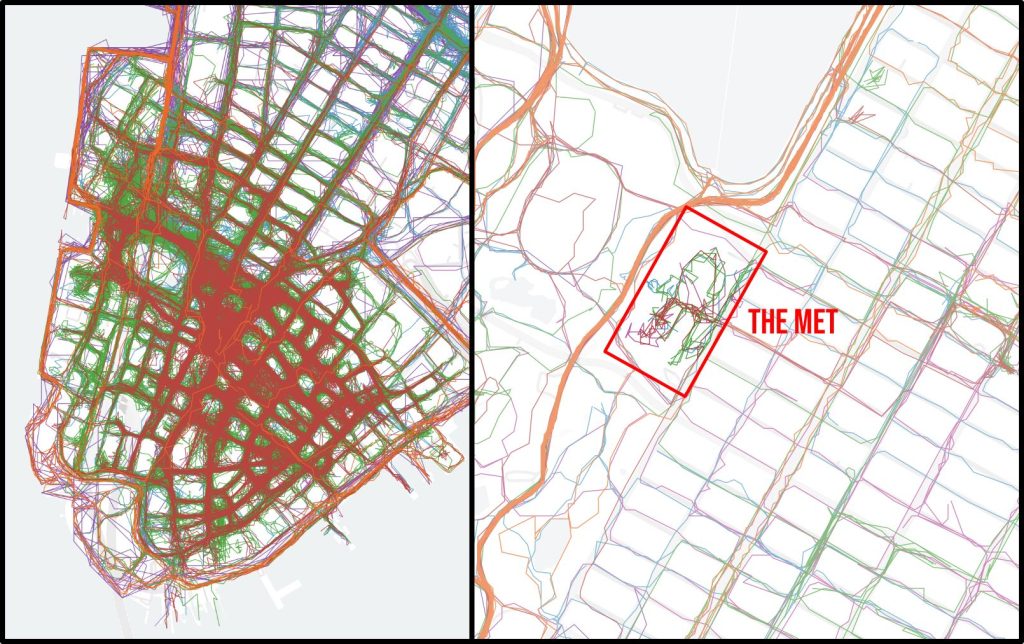Updated September 2025
I’ve always thought it would be a fun ‘side quest’ in life to walk every street, trail, and park on the planet. So for the past decade I’ve made it my mission to do that. I want to see everything. Sure, maybe walking 100 million miles is impossible in a human lifetime, but why not try? Worst case, I have a lifetime of adventures exploring every corner of the world.
Since starting this mission in 2015, I’ve GPS-tracked 50,000 miles of walking in over 200 cities and dozens of countries, averaging 10-20 miles per day, which keeps me so healthy I’m functionally immortal (I’ll write another post on this). This project will permanently be a work-in-progress.
Interactive map
This is everywhere that I have walked in NYC since 2015. Notes: in order for this to run smoothly I had to downsample the data, which makes the lines get wonky if you zoom in too far. There’s also still some data from 2015-2019 I need to upload, as well as very recent data.
Logging the data
Rather than opening a tracking app every time I go for a walk, I have my phone configured to track me 24/7 in the background. This means I capture everything, every second of every day. I’m confident I’m the first person ever to track their life like this at this level.
I often get asked how to do this. No all-in-one app exists for this, so it’s extremely difficult. If you’re committed, below is the system I use, however if you’d like to stay sane I highly recommend just using a fitness tracker like Strava synced to a tool like Citystrides or Wandrer.
- Install Arc (and maybe Arc Mini and Arc Recorder for backup) on your iPhone. These apps have a ML model that classifies the data. Occasionally you’ll have to manually classify data the model can’t sort out.
- Export the JSON data and use a Python script to parse it and strip out everything except walking. You can visualize the data on this website.
- Finally, write Python scripts to consolidate everything, convert the data to GeoJSON, downsample it to reduce file size, and upload it to Mapbox via their API as a dataset. Then convert the data to a tileset and visualize it on a custom map!
It’s neat to see how GPS inaccuracies emphasize the streets I walk most often. Neighborhoods like the Financial District are a dense cluster of lines due to the tall buildings and narrow streets making it near impossible for a phone to get line of sight with the satellites.
At the same time, GPS can be so accurate that it will track my movement within large buildings, such as IKEA or museums. For example, the data shows that whenever I visit the Met, I tend to enter via the members entrance, loop through the Temple of Dendur and make a beeline for the sculpture gallery.

Fun fact: this is an example of a four-dimensional map.
I frequently get asked how different this map would look if I didn’t have my mission to walk every street. The answer is very different; humans naturally tend towards taking familiar routes, so a ‘normal’ map would just be straight lines between your most frequent destinations. That is why I’m the first person ever to do this: some people track their walking like this, and some people walk every street, however, I’m the first person ever to do both!
New York City is my favorite city in the world and thus has the most data – since July 2015 I’ve walked about 20,000 miles here. I’m on track to finish every street in Manhattan very soon.
Feel free to pan over to other cities on the map. For example, San Francisco, where I’ve walked around 7,000 miles (75% completion), or Mexico City, where I’ve walked about 2,500 miles (5% completion). Oaxaca and Los Angeles also look decent.
I have more more writing to add to this post soon!
100% human-written | instagram | twitter | youtube | hi@jeremymaluf.com